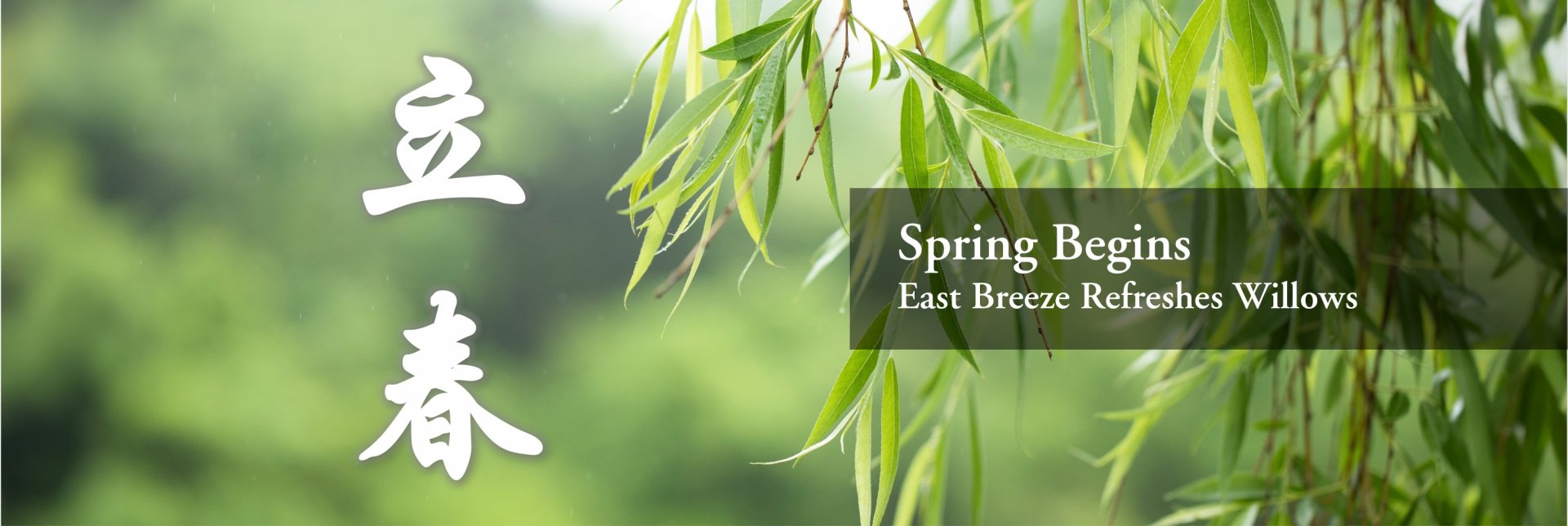Spring Begins: East Breeze Refreshes Willows
In retrospect, childhood memories on spring are the most impressive, such as the reunion dinner and lucky money on New Year’s Eve, the percussion and festive lanterns on Lantern Festival, as well as the spring pancakes on Spring Begins (alias the Beginning of Spring). In Fuzhou City, Fujian Province, spring pancakes are made of thick wheat paste. The paste is spread rapidly on a heated flat pan to form a thin round in an instant. Flipped to bake for a while, it becomes a jade-like tender spring pancake. Parents would bring some spring pancakes back home and roll fried fillings to make dainty spring rolls with a strong wheat fragrance and the odor of fresh vegetables. Later I traveled far and wide for years. Every time I miss my hometown items, spring rolls would come to my mind. Spring Begins thus becomes one of the warm festivals in life. Of course, the custom of eating spring rolls on Spring Begins is common from place to place, to which the so-called Bite of Spring is mainly related. For example, Du Fu wrote in his poem Spring Begins that “Spring dishes with shredded fresh vegetables”. Yangzhou poet Lin Sumen in Qing dynasty also mentioned spring pancakes in his 300 Odes by River Han as “Soup and noodles enhance the beauty of spring, which is rolled in a pancake.”
 spring pancakes
spring pancakesAs the first one in the 24 solar terms, Spring Begins means the beginning of a year when everything renews and spring returns to the land to fill the world with vitality, thus is given constant attention. Eating spring rolls is only one of the customs to express best wishes and expect a smooth new year. For instance, poet Wang Zi in Song dynasty wrote in his poem Spring Begins that “Mud oxen disperse the street dust. Vegetables are fresh to the fullest”, which not only described spring pancakes, but also a significant spring ceremony. In the ancient society when agriculture functioned as the main industry, strong oxen ploughing fields, pulling carts and working hard with head down were closely related to people’s production and life. As a saying goes, a good start in spring promises an efficient year. When spring begins, farmers prepare for cultivation, and pray for agriculture, diligence, good weather and a bumper harvest by whipping mud oxen. Likewise, people would post a Spring Ox Picture as a custom, wherein willow twigs symbolize a full recovery when winter is gone and spring comes; a cowboy stands for Gou Mang God (alias God of Wood, God of Spring, God of East) who governs the germination and growth of plants; and most importantly, oxen represent hard work and a promising harvest.

Spring Begins boosts not only a diversity of folk culture, but also numerous elegant literature. There were literary traditions to lament spring in ancient China, as well as graceful works to eulogize spring and its scenery. On Spring Begins, an east breeze thaws the world, willows sprout, insects start to move, and fish gradually appear in the rivers. Such exuberant vigor makes men of letter all the more interested in composing. Therefore, our history witnessed a constant boom of masterpieces that laud Spring Begins. In the aforementioned poem Spring Begins by Wang Zi in Song dynasty, a beautiful line goes as “From now on, snow is replaced by gentle breezes, as wintersweet gives way to emerging willow twigs.”Another Song poet Zhang Shi described in Inspiration on Spring Begins that when Spring Begins approaches, the lake ripples in an east breeze, plants turn green and form varied reflections. So “plants know when spring comes”, and the booming vitality overwhelms our eyes. Su Shi had even bolder lines in Shortened Form Of Magnolia: Spring Begins, “Infinite spring breezes come to the sea”, “make blossoms as peachy as flesh.”
 Magnolia in full bloom at the beginning of spring
Magnolia in full bloom at the beginning of springChinese people give such importance to the solar term, because of their homely life experience and in-depth awareness of life. The Chinese calendar we know today is actually a combination of the ancient lunar calendar and the sexagenary cycle calendar. The former is based on the lunar movement cycle, while the latter is decided by the rotation cycle of constellations, in which a full cycle of Big Dipper is regarded as a year. A year is divided into four seasons, i.e. spring, summer, autumn and winter. Each season is divided into three months, respectively Meng (first) month, Zhong (second) month and Ji (third) month. Each month consists of two solar terms. Together they form the 24 solar terms. The ancient Chinese considered the beginning of a cycle as Year Start. As early as Qin dynasty, Spring Begins was regarded as the beginning of a year. “Begin” means “to start production when spring comes”, i.e. when Yang returns to our indispensable land and plants sprout, it’s a golden season to seed and cultivate. Hence the 24 solar terms including Spring Begins reflect ancient people’s awareness of following natural laws. In the current world when our living environment deteriorates all the more, the calendars formulated by ancient Chinese and the solar term awareness still play a significant reference and enlightenment role in respecting nature, protecting all creatures and improving the quality of life.
All articles/videos are prohibited from reproducing without the permission of the copyright holder.




Welcome to leave a message:
Please Sign In/Sign Up as a member and leave a message多謝陳教授分享!立春了,要趕快計劃一吓今年的大計!
#1
Chi Seng Pun
10-02-2023 00:35:36